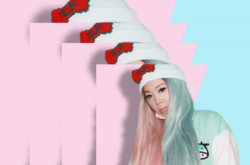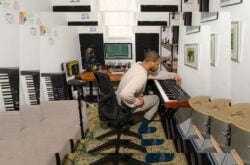BAER is a self-made pop artist from Taiwan, currently based in Los Angeles.
Her music has been featured on Sirius XM, Netflix, and Hypebeast, among many other places. With 12 years of experience in the music industry under her belt, BAER has acquired expertise in songwriting, singing, rapping, producing, and engineering across multiple styles of pop music.
In celebration of the launch of her new sample pack, BAER sat down with us to share five actionable tips from her career that helped her grow into the artist she is today—see highlights from the conversation below.
1. Believe in your own potential
While every individual’s journey to becoming the artist they dream of being is unique, believing in your own potential is a key through line that’s heard across genres, geographies, and disciplines.
“I grew up in a culture and society where pursuit of a career in the arts is usually greatly discouraged,” BAER shares with us. “Believing in myself and deciding to become an artist was a big part of my journey in getting here.”
“My time in the music industry hasn’t always been as the artist taking front stage. I actually started off assisting studio sessions, getting there hours before the artist and even the engineer, patching cables and making sure the gear and DAW were running smoothly, and leaving after everyone to make sure the studio was normalized and clean. I shadowed songwriters’ and producers’ sessions as often as I could, with the skillsets I had to offer and as a runner. I tuned vocals on Melodyne while everyone was eating lunch. Eventually, I worked my way up to sometimes engineering the sessions and vocal producing other artists.”
“When I got home, even if it was late, I was writing and recording songs furiously, fueled by the knowledge I soaked up during the day. I learned so much about vocal production from DQ (Beyoncé, Nicki Minaj), who I still consider one of the mentors who was monumental in my music career and taught me a lot of skills I still apply to this day.”
“My goal at that time was still to write for other big artists. It just never occurred to me that the artist could be… me. Like, that seemed so outrageous. But, I was on a time crunch to secure a visa to continue working in America, and since I didn’t have a label / publishing deal or any cuts, my lawyer told me to just start releasing all those songs I already had and to try to get a few blog write-ups.”
“The first song I released, ‘Breathe the Same,’ actually ended up randomly getting on the Spotify Global Viral Charts at #37, six months after it was released. Also during this time, all my friends who had previously signed publishing deals were really struggling. I was really starting to see behind the facade and understand more about the music industry; I think a lot of things combined to light a fire within me—I wanted to tell my story. At the time (and even now, still), there was such a lack of Asian representation in pop culture too, and I was just overcome by this urge to really go for it 200%. I knew I had all the skills.”
2. Learn how to record yourself
Even if you consider yourself to primarily be a songwriter or vocalist, having some level of familiarity with production can be an invaluable asset for expressing yourself and opening new doors.
“Definitely learn how to record yourself and make a great-sounding demo,” BAER urges. “My creation process has evolved so much over the years that I’ve been making music, but it’s definitely always had a big DIY component, even when I collaborate, since I have most of the skills required to make a full song and pursue a very specific vision and taste of what I want. I’ve always recorded and vocal produced all my own vocals and that will never change—these days, it’s usually just me and my mix / master engineer, King 80.”
BAER also shares one of her go-to tools for producing her own vocals. “I always recommend iZotope’s Nectar as my favorite vocal plugin,” she says. “I love that it’s for everyone—whether you’re a seasoned professional or just a beginner. It has a feature that analyzes your vocal and then finds the appropriate EQ, compression, and de-essing tweaks for that specific vocal; I’m a huge fan of this feature and still use it at the end of my vocal chain to sharpen things into focus even more. And the best part is, there’s a rent-to-own feature on Splice!“
3. Embrace different sounds and styles
A major ingredient of developing one’s own sound as an artist is blending an array of different influences, sounds, and styles—and this seems particularly true for today’s pop music.
“I don’t usually like to box my music into a single genre or sound, because it’s constantly evolving,” BAER says. “When you listen to my discography, I think you can hear that—there’s EDM, R&B, hip hop, hyperpop, singer-songwriter, and even a little country.”
“Because of my background of being a songwriter, I have skills in my arsenal that allow me to craft and create pretty much whatever I want, based on what I’m currently experiencing in life and inspired by. That being said, when I create, I definitely have a pop-leaning taste. I tend to like things that are simple and catchy and not overly complex.”
BAER’s affinity for a wide range of sounds is also reflected in her sample pack. “I’m really proud of the variety of sounds I have in it,” she tells us. “Besides the abundance of pop hooks, there are chord progressions made from my own voice, cool vocal chops, choir vocals, Buddhist chants, and dramatic dialogue, in both English and Mandarin. There’s truly something for everyone, especially if you make music in the pop realm. I really studied a lot of music I’m inspired by and took note of all the creative uses of vocals in songs beyond just the lead vocal, and applied that to this sample pack.”
4. Experiment with juxtaposition
Expanding on the above, BAER notes that leaning into juxtaposing elements can be a powerful creative strategy for yielding unique results. “I’m really proud of the production on my song ‘Kawaii,'” she says. “I actually used a sample from Splice—I remember it was a sample pack by MYLK (her packs are so awesome), and I started with the vocal chop. The ‘kawaii’ vocal really inspired me because being cute is my whole identity, so I was like, jackpot!”
“I started drawing some rhythms in, and then thought it would be really cool to juxtapose the cuteness of the vocal with a really hard, heavy-hitting, and slightly distorted 808. I added a beat and a drone sound for some tension, and that was pretty much it! The music video is also super DIY—all shot at home with my green screen and self-edited.”
5. Know when to step away
While BAER emphasizes the importance of putting in your ten thousand hours, when it comes to navigating creative blocks, throughout her years she’s also learned when to step away.
“If I’m getting paid good money from a client to write a song, I never get writer’s block,” she laughs. “Jokes aside, I’ve put in my ten thousand plus hours in songwriting to be able to write a good song if I need to.”
“That being said, as a writer, I totally get creative block. The way I overcome this is by simply stepping away. I’ve been creating long enough to know when the time feels right and an idea really needs to be birthed. Now that I’ve put in over ten thousand hours in my craft, I rarely write without a purpose. The purpose could be as simple as ‘just write a verse’ or ‘create for fun’—but I don’t like to waste energy where it’s unnecessary.”
Incorporate BAER’s sounds into your own productions
If BAER’s music and process inspired you, you can now incorporate her bold sounds directly into your own productions. “The sample pack was made in two parts,” she shares. “There are samples that are from writing and recording sessions in 2023 dedicated solely to making samples for this pack. There are also samples that are collected from the best of countless a capellas I wrote and recorded in my decade of making music professionally. I think that’s what truly makes this pack so special—it really embodies everything I’ve studied as a musician and artist.”
“I love the process of creating a sample pack because it takes so much pressure off and allows me to get super creative. I’m approaching this from so many more angles, as a songwriter, producer, and vocalist—not just as an artist. There’s so much room for different ways I can express my vocal.”
“I hope this pack inspires you to be your most creative self. Also, I will be releasing so much new music this year, so if you like what you hear on the pack, please follow along!“
Discover over 90 expertly-crafted pop vocal hooks, adlibs, choir vocals, and more:
February 9, 2024



